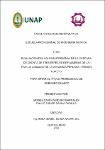Evaluación del valor nutricional de la cáscara de chonta de tres especies de palmeras de la familia Arecaceae de la amazonía peruana - región Loreto

View/
Date
2022Author
Panduro Bardales, Moises David
Dávila Padilla, Paulo Junior
Metadata
Show full item recordAbstract
The objective of the research work is to obtain the evaluation of the nutritional value of the chonta husk, of the proposed species Bactris gasipaes (Pijuayo), Mauritia flexuosa (Aguaje) and Euterpe precatoria (Huasaí) belonging to the Arecaceae family, which were collected on the Zungarococha highway, at kilometer 6, in the district of San Juan Bautista in the province of Maynas, located in the department of Loreto. For this, the standardized methods of the AOAC INTERNATIONAL (analytical communities association, 1998).
The study factors were; moisture, ash, protein, fat, fiber, carbohydrates, total acidity, vitamin C and minerals (iron, mg/100 g, calcium, mg/100 g, magnesium, mg/100 g, phosphorus, mg/100 g, sodium, mg/100 g, potassium, mg/100 g, zinc, mg/100 g).
When determining the nutritional value of the samples, we found that Mauritia flexuosa L.F has an average protein content of 1.11%, while Euterpe precatoria has 1.04% and Bactris gasipaes 3.27%. This will be detailed when displaying the results of the nutritional assessment. As for its mineral content, calcium stands out, being found in greater quantity in the Euterpe precatoria with a value of 214.75 mg/100 g.
The evaluations were carried out in the chemical analysis laboratory of the Faculty of Chemical Engineering (FIQ) of the UNAP, applying standardized methods by the AOAC INTERNATIONAL. The nutritional value is calculated by adding the amounts of fat, protein and carbohydrate content. El objetivo del trabajo de investigación es obtener la evaluación del valor nutricional de la cáscara de chonta, de las especies propuestas Bactris gasipaes (Pijuayo), Mauritia flexuosa (Aguaje) y Euterpe precatoria (Huasaí) pertenecientes a la familia Arecaceae, que fueron recolectadas en el kilómetro 6 de la carretera Zungarococha, ubicada en el distrito de San Juan Bautista, provincia de Maynas, departamento de Loreto. Se utilizó para ello, los métodos normalizados de la AOAC INTERNATIONAL (Asociación de Comunidades Analíticas, 1998).
Los factores de estudio fueron; humedad, cenizas, proteína, grasas, fibra, carbohidratos, acidez total, vitamina C y minerales (hierro, mg/100 g; calcio, mg/100 g; magnesio, mg/100 g; fósforo, mg/100 g; sodio, mg/100 g; potasio, mg/100 g; zinc, mg/100 g).
Al determinar el valor nutricional de las muestras, encontramos que Mauritia flexuosa tiene un contenido promedio de Proteína de 1,11% mientras que Euterpe precatoria tiene 1,04% y Bactris gasipaes de 3,27%. Esto será detallado al mostrar los resultados de la evaluación nutricional. En cuanto a su contenido de minerales, sobresale el calcio encontrándose en mayor cantidad en Euterpe precatoria con un valor de 214,75 mg/100 g.
Las evaluaciones se realizaron en el laboratorio de análisis químico de la Facultad de Ingeniería Química (FIQ) de la Universidad Nacional de la Amazonía Peruana (UNAP), aplicando los métodos normalizados por la AOAC INTERNATIONAL (1998). El valor nutricional se calcula sumando las cantidades en kcal/100 g del contenido de grasas, proteínas y carbohidratos.
Collections
- Tesis [198]

